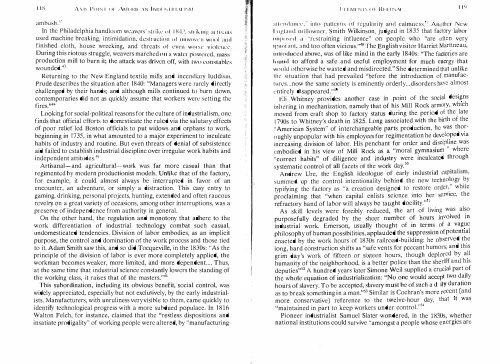CONTENTS - ouroboros ponderosa
CONTENTS - ouroboros ponderosa
CONTENTS - ouroboros ponderosa
You also want an ePaper? Increase the reach of your titles
YUMPU automatically turns print PDFs into web optimized ePapers that Google loves.
II A\I" I'( )[r--.; r (II /\r\II'I,1( ,\r"J INI11 1" ,' II, !:\1 1';1\1<br />
ambush.'\.'<br />
In the Philadelphia handlu"m weavers ' slrike oi" IX,!.', s l l ik illg ,,, I i""ls<br />
used machine breaking) intimidation. destruction Ill' lIlIWtlVl'1I wool ;11111<br />
finished cloth, house wrecking, and threats or even Will sc viOielHT.<br />
During this riotous struggle, weavers marched Oil a water powered. rna"<br />
production mill to burn it; the attack was driven off, with Iwo constables<br />
woundcd.43<br />
Returning to the New England textile mills and incendiary luddisrn.<br />
Prude describes the situation after 1840: "Managers were rarely directly<br />
challenged by their hands; and although mills continued tu hurn down,<br />
contemporaries did not as quickly assume that workers were setting the<br />
fires."44<br />
LOOking for social-political reasons for the culture of industrialism, one<br />
finds that official dIorts to domesticate the ruled via the salutary effects<br />
of poor relief led Boston officials to put widows and orphans to work,<br />
beginning in 1735, in what amounted to a major experiment to inculcate<br />
habits of industry and routine. But even threats of denial of subsistence<br />
aid failed to establish industrial discipline over irregular work habits and<br />
independent attitudes."<br />
Artisanal-and agricultural-work was far more casual than that<br />
regimented by modern productionist models. Unlike that of the factory,<br />
for example, it could almost always be interrupted in favor of an<br />
encounter, an adventure, or simply a distraction. This easy entry to<br />
gaming, drinking, personal projects, hunting, extended and often raucous<br />
revelry on a great variety of occasions, among other interruptions, was a<br />
preselVe of independence from authority in general.<br />
On the other hand, the regulation and monotony that adhere to the<br />
work differentiation of industrial technology combat such casual,<br />
undomesticated tendencies. Division of labor embOdies, as an implicit<br />
purpose, the control and domination of the work process and those tied<br />
to it. Adam Smith saw this, and so did Tocqueville, in the 1830s: "As the<br />
principle of the division of labor is ever more completely applied, the<br />
workman becomes weaker, more limited, and more dependent.... Thus,<br />
at the same time that industrial science constantly lowers the standing of<br />
the working class, it raises that of the masters.""<br />
This suhordination, including its obvious benefit, social control, was<br />
widely appreciated, especially but not eXClUSively, by the early industrial<br />
ists. Manufacturers, with unruliness very visible to them, came quickly to<br />
identify technological progress with a morc subdued populace. In 1816<br />
Walton Felch, for instance, claimed that the "restless dispositions and<br />
insatiate prodigality" of working people were altered, by "manufacturing<br />
+<br />
' I,<br />
l'I I ' 1\1 IN1S cll' I{I'I'I I;!\I<br />
:lllt'nd:IIHT," into patterns ur rq',u\,lrity and calmness"l1 Another New<br />
I :")',I""d lIlilloWIlCl", Smith Wilkinson, judged in 1835 that factory lahor<br />
illljl' lsrd a "restraining intluencc" on people who 'are often very<br />
,<br />
'1lIllrallt. and too often vicious."48 The English visitor Harriet Mart lflcau,<br />
.<br />
inlroduced above, was of like mind in the early 1840s: "The faclones arc<br />
Ii ,ulul to afford a safe and useful employment for much energy that<br />
would otherwise be wasted and misdirected." She determined that unhke<br />
Iile situation that had prevailed "hefore the introduction of manufacillrcs<br />
... now the same society is eminently orderJy ... disorders have almost<br />
l."ntlre . I y d' lsappeare d . ,,49<br />
.<br />
I:h Whitney provides another caSe in point of the social deSIgns<br />
illlwring in mechanization, namely that of his Mill Rock armory, whIch<br />
moved from craft shop to factory status during the period of the late<br />
1790s to Whitney's death in 1825, Long associated with the birth of the<br />
"American System" of interchangeable parts production, he was tho : <br />
tlugh1y unpopular with his employees for regimentation he developed vIa<br />
increasing division of labor. His penchant for order and discrptrne was<br />
embodied in his view of Mill Rock as a "moral gymnasium " where<br />
"correct habits" of diligence and industry were inculcated through<br />
systematic control of all facets of the work day '·<br />
. .<br />
Andrew Ure, the English ideologue of early industrial caprtah sm,<br />
summed up the control intentionality behind the new technO?gy by<br />
typifying the factory as "a creation designed to restore order : whlle<br />
proclaiming that "when capital enlists science into her se[Vrce, the<br />
refractory hand of labor will always be taught doeility."'1<br />
As skill levels were forcibly reduced, the art of living was also<br />
purposefully degraded by the sheer number of bours involved m<br />
industrial work. Emerson, usually thought of in terms at a vague<br />
philosophy of human possibilities, applauded the suppression of potenllal<br />
enacted by the work hours of 1830s railroad-building: he obselVed the<br />
long, hard construction shifts as "safe vents for peccant humors; and thrs<br />
grim day's work of fifteen or sixteen hours, though deplor . ed by all<br />
humanity of the neighborhood, is a better police than the shenff and hI'S<br />
deputies"" A hundred years later Simone Weil supplied a cruClal part of<br />
the whole equation of industrialization: "No one would accept two dar ly<br />
hours of slavery, To be accepted, slavery must be of such a daily duratr on<br />
as to break something in a man."" Similar is Cochran's more recent (and<br />
more eonselVative) reference to the twelve-hour day, that It was<br />
"maintained in part to keep workers under controL""<br />
Pioneer industrialist Samuel Slater wondered, in the 1830s, whether<br />
national institutions could sUlVive "amongst a people whose energies arc<br />
I I ')






